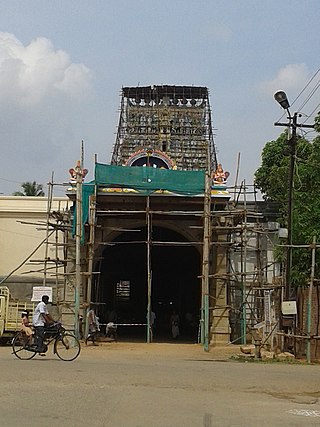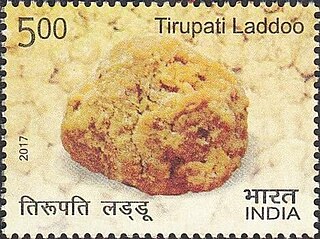Related Research Articles

Venkateswara, also known as Venkatachalapati, Balaji and Srinivasa, is a Hindu deity, described as a form or avatar of the god Vishnu. He is the presiding deity of Venkateswara Temple, Tirupati. His consorts, Padmavathi and Bhudevi, are avatars of the goddess Lakshmi, the consort of Vishnu.

Tirumala Tirupati Devasthanams (TTD) is an independent government trust in India managed by the Government of Andhra Pradesh. The trust primarily oversees the operations and finances of the richest and the most visited religious center Venkateswara Temple, Tirumala. It is also involved in various social, religious, literary and educational activities. TTD is headquartered at Tirupati in Andhra Pradesh, India and employs about 16,000 people.

Tirumala is a spiritual place in Tirupati district of the Indian state of Andhra Pradesh. It is one of the neighbourhoods of the Tirupati city. The town is a part of Tirupati Urban Development Authority and located in Tirupati (urban) mandal of Tirupati revenue division. The town is strictly vegetarian. It is a hill town where Tirumala Venkateswara Temple is located, a popular shrine of Vishnu. Vishnu was considered to reside here with his full power, as in Vaikuntha, and thus the place was also called 'Bhuloka Vaikuntha'.

The Parthasarathy Temple is a 6th-century Hindu Vaishnavite temple dedicated to Vishnu in Chennai, India. Located in the neighbourhood of Thiruvallikeni, the temple is glorified in the Naalayira Divya Prabandham, the early medieval Tamil literature canon of the Alvar saints from the 6th to 9th centuries CE and is classified as among the 108 Divya Desams dedicated to Vishnu. The name 'Parthasarathy' means the 'charioteer of Arjuna', referring to Krishna's role as a charioteer to Arjuna in the epic Mahabharata.

Tirupati is a city in the Indian state of Andhra Pradesh and serves as the administrative headquarters of Tirupati district. It is known for its significant religious and cultural heritage, being home to the renowned Tirumala Venkateswara Temple, a major Hindu pilgrimage site, as well as other historic temples. The temple is one of the eight Svayam Vyakta Kshetras dedicated to the deity Vishnu. Tirupati is situated 150 km from Chennai, 250 km from Bangalore, and 406 km from Amaravati.

Sri Venkateswara Swami Vari Brahmotsavam or Srivari Brahmotsavam is the most significant annual fête celebrated at the Venkateswara Temple in Tirumala-Tirupati, Tirupati district, Andhra Pradesh, India. which falls between the Telugu calendar of Aasveeyujamu and the Gregorian calendar months of September or October.

The Venkateswara Temple of Tirumala, called Sri Venkateswara Swami Temple, is a Hindu temple situated in the hills of Tirumala at Tirupati Urban Mandal in the Tirupati district of Andhra Pradesh, India. The temple is dedicated to Venkateswara, a form of Vishnu, who is believed to have appeared on the earth to save mankind from trials and troubles of Kali Yuga. Hence the place is also known by the name Kaliyuga Vaikuntha and the deity here is referred to as Kaliyuga Prathyaksha Daivam. The temple is also known by other names like Tirumala Temple, Tirupati Temple and Tirupati Balaji Temple. Venkateswara is also known by other names including Balaji, Govinda, and Srinivasa. The temple is run by Tirumala Tirupati Devasthanams (TTD), which is under control of Andhra Pradesh Government. The head of TTD is appointed by Andhra Pradesh Government.

Sri Venkateswara Bhakthi Channel is the pioneer devotional (bhakthi) channel of TTD. It is the first 24-hour satellite Telugu devotional channel dedicated to broadcasting Hindu devotional programs and live telecasts of poojas performed in the Tirumala Tirupati Devasthanams from Tirupati in Andhra Pradesh, India.
Bruce's Code is a set of rules for the management and administration of temples of Tirumala and Tirupati including the servants, enacted by East India Company in 1821 AD.

Pandavatutar Perumal Temple or Thirupadagam located in Kanchipuram in the South Indian state of Tamil Nadu, is dedicated to the Hindu god Krishna, an avatar of the god Vishnu. Constructed in the Dravidian style of architecture, the temple is extolled in the Nalayira Divya Prabandham, the early medieval Tamil canon of the Alvar saints from the 6th–9th centuries CE. It is one of the 108 Divya Desams dedicated to Vishnu, who is worshipped as Pandava Tutar Perumal (Krishna) and his consort Lakshmi (Rukmini.)

The Vanamamalai Perumal Temple, also known as Arulmigu Sree Vanamamalai Totatri Perumal Temple is a Hindu temple dedicated to the god Vishnu, in Vanamamalai or Totadrikshetram (Nanguneri), Tamil Nadu, India on the banks of Thamiraparani river. Constructed in the Dravidian style of architecture, the temple is glorified in the Nalayira Divya Prabandham, the early medieval Tamil canon of the Alvar saints from the 6th–9th centuries CE. It is one of the 108 Divya Desams shrines dedicated to Vishnu. Vishnu is worshipped here as Vanamalai Perumal and his consort Lakshmi as Varamanagi. The temple is believed to have been built by the Pandyas, with later contributions from Vijayanagara kings and Madurai Nayaks. The temple covers an area of 5 acres (20,000 m2) and has a five-tiered temple tower.

Kodandarama Temple is a Hindu temple dedicated to the god Rama, located in Vontimitta town in Vontimitta Mandalam of Kadapa District in the Indian state of Andhra. The temple, an example of Vijayanagara architectural style, is dated to the 16th century. It is stated to be the largest temple in the region. It is located at a distance of 25 kilometres (16 mi) from Kadapa and is close to Rajampet. The temple and its adjoining buildings are one of the centrally protected monuments of national importance.

Tirupati laddu, also known as Tirumala laddu or Srivari laddu, is a popular sweet offered as prasadam at the Venkateswara Temple in Tirupati, Andhra Pradesh, India. First introduced in 1715, the laddu evolved from a sweet called Manoharam and is now prepared in the temple's kitchen, Laddu Potu, by the Tirumala Tirupati Devasthanams (TTD). Over 600 people, including skilled cooks known as Pachakas, are involved in its production. The laddu received a Geographical Indication (GI) tag in 2009 to protect its authenticity. There are variations of the laddu, including the Proktham Laddu and Asthanam Laddu. In 2024, it was at the centre of a controversy over alleged adulteration, leading to investigations and a purification ritual.

Sri Prasanna Venkateswara Swamy Temple is a temple at Appalayagunta, Tirupati located in Tirupati district of Andhra Pradesh, India. The temple is dedicated to the Hindu deity Venkateswara, referred to as Prasanna Venkateswara. Unlike other typical Venkateswara temples, the presiding deity has its right hand in Abhaya posture.

Kalyana Venkateswara Temple is an ancient Hindu temple at Srinivasamangapuram in Tirupati. It is located in Tirupati District of Andhra Pradesh, India. The temple is dedicated to the god Venkateswara, a form of Vishnu and is referred to as Kalyana Venkateswara. The temple is one of the centrally protected monuments of national importance.

Sri Kalyana Venkateswara Swamy Temple is a Hindu temple situated at Narayanavanam, a town in Tirupati district of Andhra Pradesh state, India. The Temple is dedicated to Kalyana Venkatesvara, a form of Vishnu. The temple is situated at 2 km east of Puttur and 45 km south of Tirupati. It is believed that Venkatesvara married his consort Padmavathi at this place and then moved to Tirumala.

Adi moola Srinivasa Perumal Temple or Adi moola Venkataramanaswamy Temple is a Hindu temple dedicated to Vishnu located in a village called Mookanur, in the Dharmapuri district, Tamil Nadu, India. Constructed in the Dravidian style of architecture, it is believed to have been built by the Pallava dynasty. It is considered one among the 108 Abhimana Kshethram of Vaishnavate tradition. The temple is Constructed in the foot hill of a mountain Dedicated entaierly to Vishnu. This structure was earlier maintained by Tenkalai Brahmins and now is maintained and administered by the Hindu Religious and Charitable Endowments Department, follows the Vaikhanasa agama and is a pure Vaishnavate temple. There is no Ganesha shrine inside the temple complex. The divine-deity is the Kula-devata of many Brahmins and Gounder's in the Dharmapuri district.

The Pancha Kshetrams or Pancha Bhargavi Kshethram is a group of five sacred Hindu temples in India, dedicated to the deity Vishnu and Lakshmi With the legend associated to the Venkateswara Temple, Tirumala. All the temples are Divya desams except one which is an Abhimana Kshethram.

In Devuni Kadapa, Andhra Pradesh, Sri Lakshmi Venkateshwara Swamy Devasthanam temple stands. The temple is dedicated to Lord Venkateswara and serves as a spiritual prelude for pilgrims en route to the Tirumala Venkateswara Temple. It is also known as Tirumala Tholi Gadapa. Famous for its religious harmony and cultural importance, the temple draws pilgrims from varied backgrounds.
References
- ↑ Sharma, Arvind; Young, Katherine K., eds. (1999). Feminism and World Religions. State University of New York. p. 48. ISBN 0-7914-4023-0.
- 1 2 Dr. N.Ramesan (1981). The Tirumala Temple. Tirumala: Tirumala Tirupati Devasthanams.
- ↑ "Tirumala Tirupati Devasthanams: Temple History". Archived from the original on 12 April 2012. Retrieved 15 July 2011.
- ↑ TTD News. "Pontiffs Jeeyangars, the Ombudsman of Tirumala Temple rituals". Archived from the original on 24 October 2021.
- ↑ "Voice of a mighty philosophy". The Hindu. 25 March 2010.
- ↑ Narasimhan, T. a (16 June 2016). "He streamlined the rituals at Tirumala temple". The Hindu.
- 1 2 Kameswara Rao, V. (1986). Temples in and Around Tirupati.
- 1 2 3 V.K, Bhaskara Rao (1992). Organisational and Financial Management of Religious Institutions: With Special Reference to Tirumala Tirupati Devasthanams (TTD). Deep and Deep Publications. pp. 52, 53. ISBN 81-7100-441-5.
- ↑ Koutha, Nirmala Kumari (1 January 1998). History of the Hindu Religious Endowments in Andhra Pradesh. Northern Book Centre. p. 124. ISBN 81-7211-085-5.
- 1 2 3 Koutha, Nirmala Kumari (1 January 1998). History of the Hindu Religious Endowments in Andhra Pradesh. Northern Book Centre. p. 136. ISBN 81-7211-085-5.
- ↑ Sastry, Sadhu Subrahmanya (1930). Report on the Inscriptions of the Devasthanam Collection with Illustrations, Issued Under the Authority of Sri Mahant Prayagadasji Varu. Printed at Tirupati Sri Mahant's Press.
- ↑ "Tirumala Tirupati Devastanamulu". Tirumala.org. Archived from the original on 6 August 2002. Retrieved 17 June 2013.
